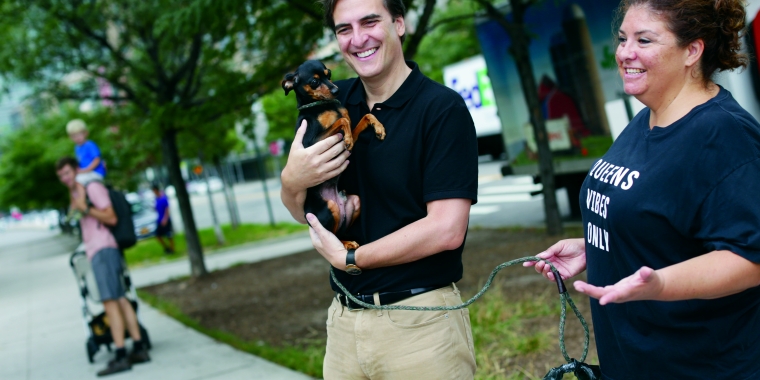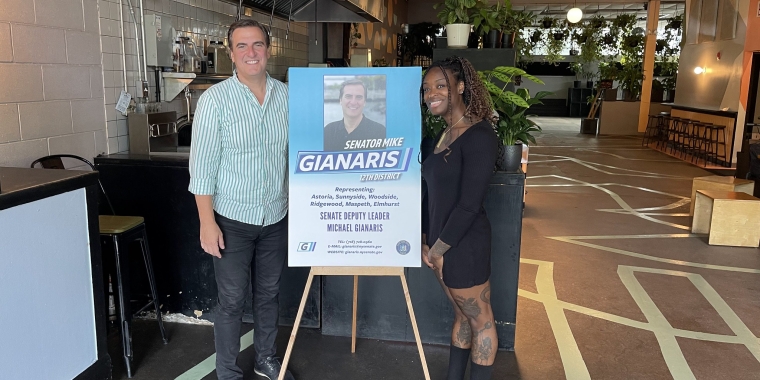
Times Union: Now in New York, insurers can't reject you for what kind of dog you own

ALBANY — A new state law prohibits insurance companies from refusing to provide insurance to homeowners based on dog breeds, a move that's drawing praise from pet owners who say some dogs are unfairly maligned as inherently violent.
“It’s not fair to the animals and not fair to the homeowners who want to give their pets loving homes,” said Libby Post, executive director of the NYS Animal Protection Federation.
For pet rescue shelters and animal rights advocates, lifting the restrictions on what they have long contended are unfairly maligned breeds is long overdue.
"Removing this arbitrary and discriminatory impediment for thousands of responsible New York dog owners is simply the right thing to do," said Bill Ketzer, senior director of state legislation for the ASPCA: Eastern Division, in a statement.
Among the previously prohibited canines are pit bulls, a breed with a reputation for being aggressive. An entire industry has cropped up over the past several decades that encourages the breed's stereotype, critics say, including products like muscle builder and the dog’s image in pop culture, as well as outsized media coverage of attacks.
But advocates contend the breed has been co-opted by irresponsible owners, many of whom view them as a menacing status symbol rather than a beloved pet.
“There’s no evidence that any breed of an animal is inherently more violent,” said Ashley Jeffrey Bouck, chief executive officer of the Mohawk Hudson Humane Society. “It really is the biggest myth going that you can determine their behavior.”
And those misperceptions have resulted in insurance carriers historically having the right to decline issuing homeowners insurance to pit bull owners and other breeds, including German shepherds or Doberman pinschers, until Gov. Kathy Hochul signed legislation last October barring the practice.
It was also legal for home insurance premiums to be raised based on the breed of dog owned.
Prior to Hochul signing the broader animal welfare package, insurance companies had a list of breeds on a caution list, said Don Ferlazzo, owner of insurer the Ferlazzo Agency in Clifton Park, who called the practice “discriminatory.”
Other breeds were banned outright.
“It precluded someone from rescuing an animal who fit such guidelines,” Ferlazzo said.
Pit bulls have historically been bred to be fighters, he said, hence the stereotype. And since the dogs are raised to be protective, they’re perceived to be harder to control.
Advocates, however, claim their disposition is a question of “nature versus nurture,” and that behavior isn’t naturally inherited but learned, and that the breed is affectionate and is wonderful with children (the dog in “The Little Rascals” is, in fact, a pit bull, Post pointed out).
Pit bull mixes tend to dominate the dogs available for adoption at local shelters.
Yet Bouck said it’s impossible to pinpoint the specific breed without DNA testing or documentation that proves their purebred status.
Joseph Lisella, executive director of the Animal Protective Foundation in Glenville, estimated more than half of the dogs that come into the shelter could be categorized as pit bull mixes.
Typically, they are at the shelter slightly longer than other breeds based on client demand.
“Pit bulls have just become a prominent fixture in shelters nationwide,” Lisella said. “They are larger, strong dogs and owners have to be educated to make sure each individual dog is a key member of the household.”
There are several reasons why so many pit bulls end up at shelters.
Post said the canines are more prevalent in heavily populated areas, including New York City and Long Island. Many are picked up by animal control officers because they’re unlicensed or not outfitted with micro-chips. Then they’re transported upstate for adoption.
“It comes down to economic access,” Bouck said. “When people don’t have resources, [the dogs] are not socialized and more prone to attack.”
Mia Johnson, co-founder of National Pit Bull Victim Awareness, pointed to a long list of fatal maulings by the breed as evidence of what she believes is their inherent threat.
Fifty people in the U.S. were killed by dogs last year, she said, and 36 of the 50 fatalities were by pit bulls and pit bull mixes. Thousands more were injured, many seriously, she said.
“The cost to the system is unspeakable,” Johnson said in an email. “Victims of pit bull attacks require millions of dollars in emergency and reconstructive surgery, often over a period of many years.”
Pit bull attacks are also disproportionate in number and their severity, she said: Ninety percent of injuries involve the head–neck region and almost three-quarters of attacks are of major severity.
Furthermore, the attacks come with significant price tags, she said.
The total cost of dog-bite and related injury claims paid by insurers exceeds $850 million annually – not including pit bull bites, according to Johnson.
“Liability limited to a maximum of $100,000 to $300,000 is rarely sufficient to cover the actual and long-term medical costs of a pit bull attack,” Johnson said.
DogsBite.org, a public education website about dangerous dog breeds, said insurance companies are for-profit entities and questioned why they should be required to pay out for any dog bite injuries if they can't restrict certain breeds that repeatedly appear in medical studies for “inflicting more severe injuries than other breeds.”
“Why pay out for any dog bite injuries if they can't restrict a dog of any breed that has a history of multiple bites, but has not been designated a dangerous dog, which can involve a lengthy adjudication process?” said Colleen Lynn, president and founder of the website. “It's unknown what the results will be five years after the bill is signed into law.”
The NYS Animal Protection Federation pushed back, and said part of the breed’s stigma can be attributed to outsized media coverage of dog bites.
“People are bitten by dogs every day,” according to a white paper written by the organization, “but certain breeds get more news coverage than others.”
Starting in the 1980s, highly publicized pit bull attacks served to create negative sentiment against the breed.
“A chihuahua bite is not likely to make the news, but a Rottweiler or pit bite is sure to get covered,” the paper said. “This only serves to reinforce bias that the general public has against certain breeds that are characterized as aggressive and this may serve as the basis for insurance discrimination.”
Advocates also say many people lack the resources to spay or neuter pit bull puppies, hence their rapid proliferation — and their disposition to attack.
“Dogs who haven’t been fixed are nearly three times as likely to attack as those who have been and account for 95 percent of all fatal maulings,” PETA President Ingrid Newkirk told the Times Union. “Legislators can protect their constituents — and animals — by supporting laws that require dogs and cats to be spayed or neutered in order to reduce the number of attacks.”
The legislation barring breed discrimination was sponsored by state Sen. Michael Gianaris, D-Queens, and state Assembly member Linda Rosenthal, a Manhattan Democrat.
While a major hurdle has been passed, advocates now want to extend the ban to renters insurance, a wish list for this year’s legislative session. One bill already has co-sponsorship.
Bouck, the Mohawk Hudson Humane Society CEO, said the issue is more salient than ever now that the state’s eviction moratorium, first enacted in 2020, is set to expire on Jan. 15. Fourteen thousand people are at risk of losing their home in Albany and Rensselaer counties alone, she said.
“If people are relocating out of their current homes, we don’t want the breed to be the reason for not taking their pets,” Bouck said.



